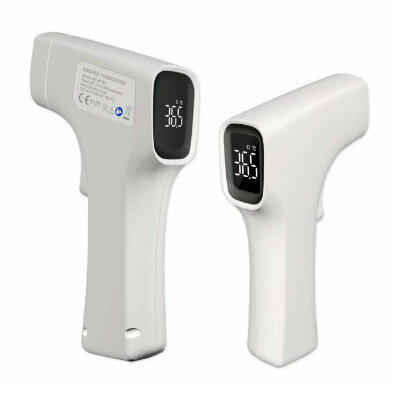Robotic System Remotely Operates Ventilators in COVID-19 Wards 
|
By HospiMedica International staff writers Posted on 25 Aug 2020 |

Image: A robotic assistant adjusts ventilator parameters remotely (Photo courtesy of JHU)
A new robotic system allows medical staff to remotely operate ventilators and other bedside machines from outside intensive care rooms of patients suffering from infectious diseases.
Developed at Johns Hopkins University (JHU; Baltimore, MD, USA) and Johns Hopkins Medicine (JHM; Baltimore, MD, USA), the robotic device is affixed to the ventilator's touch screen with a horizontal bar that is secured across the top edge. The bar serves as a stationary track for the back-and-forth movement of two connected vertical bars that extend the full height of the screen. As the vertical bars sweep across the screen, a stylus they carry moves up and down according to its commands, similar to how an Etch A Sketch moves its drawing tool along an X-Y axis.
A camera connected to the top bar sends an image of the screen to the operator's tablet outside the room. The system is still being tested, but in initial trials at the Johns Hopkins Hospital biocontainment unit, a tablet was used to remotely change oxygen percentage and volume delivered by a ventilator to a mannequin in an adjoining room. According to the developers, the robotic system can be deployed to help hospitals preserve protective gear, limit staff exposure to COVID-19, and provide more time for clinical work.
“Routine adjustments typically take just a couple minutes inside a room. But putting on and removing gear added an additional six minutes to the process. Doing that 10 times in a single shift steals an entire hour that could have been spent delivering patient care,” said respiratory therapist Jonathan Cope, who assisted with the project. “This remote-control system will be a force multiplier for our frontline clinicians. Being able to save time to deliver more care to more patients will pay huge dividends when we face massive patient surges during pandemicsm.”
The COVID-19 pandemic spurred a surge of highly infectious patients requiring ventilators, infusion pumps, and other equipment. Treating such intensive care patients requires personnel to don and doff personal protective equipment (PPE) every time, even for minor adjustments to machines. The process burns through limited supplies, and also wastes valuable time and personnel as the procedure requires an additional person to assist with the changing of gowns, gloves, masks, and other gear.
Related Links:
Johns Hopkins University
Johns Hopkins Medicine
Developed at Johns Hopkins University (JHU; Baltimore, MD, USA) and Johns Hopkins Medicine (JHM; Baltimore, MD, USA), the robotic device is affixed to the ventilator's touch screen with a horizontal bar that is secured across the top edge. The bar serves as a stationary track for the back-and-forth movement of two connected vertical bars that extend the full height of the screen. As the vertical bars sweep across the screen, a stylus they carry moves up and down according to its commands, similar to how an Etch A Sketch moves its drawing tool along an X-Y axis.
A camera connected to the top bar sends an image of the screen to the operator's tablet outside the room. The system is still being tested, but in initial trials at the Johns Hopkins Hospital biocontainment unit, a tablet was used to remotely change oxygen percentage and volume delivered by a ventilator to a mannequin in an adjoining room. According to the developers, the robotic system can be deployed to help hospitals preserve protective gear, limit staff exposure to COVID-19, and provide more time for clinical work.
“Routine adjustments typically take just a couple minutes inside a room. But putting on and removing gear added an additional six minutes to the process. Doing that 10 times in a single shift steals an entire hour that could have been spent delivering patient care,” said respiratory therapist Jonathan Cope, who assisted with the project. “This remote-control system will be a force multiplier for our frontline clinicians. Being able to save time to deliver more care to more patients will pay huge dividends when we face massive patient surges during pandemicsm.”
The COVID-19 pandemic spurred a surge of highly infectious patients requiring ventilators, infusion pumps, and other equipment. Treating such intensive care patients requires personnel to don and doff personal protective equipment (PPE) every time, even for minor adjustments to machines. The process burns through limited supplies, and also wastes valuable time and personnel as the procedure requires an additional person to assist with the changing of gowns, gloves, masks, and other gear.
Related Links:
Johns Hopkins University
Johns Hopkins Medicine
Latest Patient Care News
- Surgical Capacity Optimization Solution Helps Hospitals Boost OR Utilization

- Game-Changing Innovation in Surgical Instrument Sterilization Significantly Improves OR Throughput
- Next Gen ICU Bed to Help Address Complex Critical Care Needs
- Groundbreaking AI-Powered UV-C Disinfection Technology Redefines Infection Control Landscape
- Clean Hospitals Can Reduce Antibiotic Resistance, Save Lives
- Smart Hospital Beds Improve Accuracy of Medical Diagnosis
- New Fast Endoscope Drying System Improves Productivity and Traceability
- World’s First Automated Endoscope Cleaner Fights Antimicrobial Resistance
- Portable High-Capacity Digital Stretcher Scales Provide Precision Weighing for Patients in ER
- Portable Clinical Scale with Remote Indicator Allows for Flexible Patient Weighing Use
- Innovative and Highly Customizable Medical Carts Offer Unlimited Configuration Possibilities
- Biomolecular Wound Healing Film Adheres to Sensitive Tissue and Releases Active Ingredients
- Wearable Health Tech Could Measure Gases Released From Skin to Monitor Metabolic Diseases
- Wearable Cardioverter Defibrillator System Protects Patients at Risk of Sudden Cardiac Arrest
- World's First AI-Ready Infrasound Stethoscope Listens to Bodily Sounds Not Audible to Human Ear
- POC Diagnostic Platform Offers Handheld, Instrument-Free PCR Testing for STIs
Channels
Artificial Intelligence
view channel
AI-Powered Algorithm to Revolutionize Detection of Atrial Fibrillation
Atrial fibrillation (AFib), a condition characterized by an irregular and often rapid heart rate, is linked to increased risks of stroke and heart failure. This is because the irregular heartbeat in AFib... Read more
AI Diagnostic Tool Accurately Detects Valvular Disorders Often Missed by Doctors
Doctors generally use stethoscopes to listen for the characteristic lub-dub sounds made by heart valves opening and closing. They also listen for less prominent sounds that indicate problems with these valves.... Read moreCritical Care
view channel
Deep-Learning Model Predicts Arrhythmia 30 Minutes before Onset
Atrial fibrillation, the most common type of cardiac arrhythmia worldwide, affected approximately 59 million people in 2019. Characterized by an irregular and often rapid heart rate, atrial fibrillation... Read more
Breakthrough Technology Combines Detection and Treatment of Nerve-Related Disorders in Single Procedure
The peripheral nervous system (PNS) serves as the communication network that links the brain and spinal cord to every other part of the body. It consists of two parts: the somatic nervous system, which... Read moreSurgical Techniques
view channel
Hydrogel-Based Miniaturized Electric Generators to Power Biomedical Devices
The development of engineered devices that can harvest and convert the mechanical motion of the human body into electricity is essential for powering bioelectronic devices. This mechanoelectrical energy... Read moreWearable Technology Monitors and Analyzes Surgeons' Posture during Long Surgical Procedures
The physical strain associated with the static postures maintained by neurosurgeons during long operations can lead to fatigue and musculoskeletal problems. An objective assessment of surgical ergonomics... Read more.jpg)
Custom 3D-Printed Orthopedic Implants Transform Joint Replacement Surgery
The evolving field of 3D printing is revolutionizing orthopedics, especially for individuals requiring joint replacement surgeries where traditional implants fail to provide a solution. Although most people... Read more
Cutting-Edge Imaging Platform Detects Residual Breast Cancer Missed During Lumpectomy Surgery
Breast cancer is becoming increasingly common, with statistics indicating that 1 in 8 women will develop the disease in their lifetime. Lumpectomy remains the predominant surgical intervention for treating... Read moreHealth IT
view channel
Machine Learning Model Improves Mortality Risk Prediction for Cardiac Surgery Patients
Machine learning algorithms have been deployed to create predictive models in various medical fields, with some demonstrating improved outcomes compared to their standard-of-care counterparts.... Read more
Strategic Collaboration to Develop and Integrate Generative AI into Healthcare
Top industry experts have underscored the immediate requirement for healthcare systems and hospitals to respond to severe cost and margin pressures. Close to half of U.S. hospitals ended 2022 in the red... Read more
AI-Enabled Operating Rooms Solution Helps Hospitals Maximize Utilization and Unlock Capacity
For healthcare organizations, optimizing operating room (OR) utilization during prime time hours is a complex challenge. Surgeons and clinics face difficulties in finding available slots for booking cases,... Read more
AI Predicts Pancreatic Cancer Three Years before Diagnosis from Patients’ Medical Records
Screening for common cancers like breast, cervix, and prostate cancer relies on relatively simple and highly effective techniques, such as mammograms, Pap smears, and blood tests. These methods have revolutionized... Read morePoint of Care
view channel
Critical Bleeding Management System to Help Hospitals Further Standardize Viscoelastic Testing
Surgical procedures are often accompanied by significant blood loss and the subsequent high likelihood of the need for allogeneic blood transfusions. These transfusions, while critical, are linked to various... Read more
Point of Care HIV Test Enables Early Infection Diagnosis for Infants
Early diagnosis and initiation of treatment are crucial for the survival of infants infected with HIV (human immunodeficiency virus). Without treatment, approximately 50% of infants who acquire HIV during... Read more
Whole Blood Rapid Test Aids Assessment of Concussion at Patient's Bedside
In the United States annually, approximately five million individuals seek emergency department care for traumatic brain injuries (TBIs), yet over half of those suspecting a concussion may never get it checked.... Read more
New Generation Glucose Hospital Meter System Ensures Accurate, Interference-Free and Safe Use
A new generation glucose hospital meter system now comes with several features that make hospital glucose testing easier and more secure while continuing to offer accuracy, freedom from interference, and... Read moreBusiness
view channel
Johnson & Johnson Acquires Cardiovascular Medical Device Company Shockwave Medical
Johnson & Johnson (New Brunswick, N.J., USA) and Shockwave Medical (Santa Clara, CA, USA) have entered into a definitive agreement under which Johnson & Johnson will acquire all of Shockwave’s... Read more
















